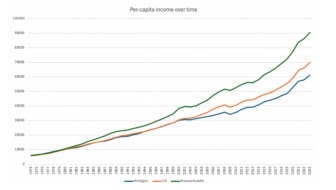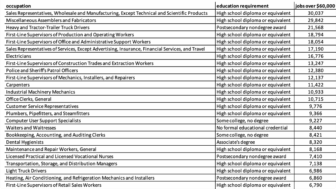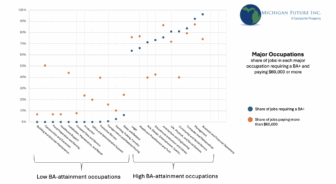![]() I’ve been thinking a lot lately about why middle class life feels increasingly unstable over these last several years—especially in Michigan. Frequent readers of MFI know that we often cite the Michigan Association of United Way’s ALICE report, and its startling headline figure that 40 percent of Michigan households can’t afford basic necessities. Those figures are pretty crystal clear. Life is financially precarious at this income level. On top of the day-to-day challenges, these families (many who are employed) are one health crisis, totaled car, or new roof away from taking on debt. The ALICE report shares a bare-bones budget for a Michigan family that factors in expected costs. That budget, while it varies with costs of living around the state, averages at needing just over $56,000 to survive.
I’ve been thinking a lot lately about why middle class life feels increasingly unstable over these last several years—especially in Michigan. Frequent readers of MFI know that we often cite the Michigan Association of United Way’s ALICE report, and its startling headline figure that 40 percent of Michigan households can’t afford basic necessities. Those figures are pretty crystal clear. Life is financially precarious at this income level. On top of the day-to-day challenges, these families (many who are employed) are one health crisis, totaled car, or new roof away from taking on debt. The ALICE report shares a bare-bones budget for a Michigan family that factors in expected costs. That budget, while it varies with costs of living around the state, averages at needing just over $56,000 to survive.
Who I’ve been thinking about are families whose incomes meet that threshold—but who still feel like they are struggling.
Lots has been written about feelings of insecurity and my aim here is not to get into the psychology that might be accompanying our rapidly changing, increasingly global and automated economy—while we’re all still recovering from the Great Recession. I just want to look at little bit more at other costs and what income level might allow you to feel comfortable in Michigan today.
67.7 percent of Michigan households make $75,000 or less each year, according to the American Community Survey data. That means that—if you take away the 40 percent who can’t cover basic necessities, there are almost 30 percent of Michigan households making just above the ALICE threshold but less than $75,000.
The household budget included in the ALICE report includes housing, transportation, food, health care, taxes, a “miscellaneous” line item, and childcare for one child—all based on Michigan averages. It doesn’t include childcare for more than one child, extracurriculars, tutoring, or other activities for your children, contributing towards your child’s college cost, even a modest vacation, or, most significantly, savings, for a rainy day fund or for retirement.
I don’t think the list of expenses I just made can be described as indulgent in any way. On top of that, the savings we should all be setting aside isn’t chump change. A retirement guide prepared by Fidelity suggests that in your 20s, you should save 25 percent of your salary every year; you should have one year of your salary saved by age 30, two years by 35, and so on. Apparently almost no one is following this guide because half of American families have no retirement savings, and 70 percent have $1000 or less in savings.
If a family was making $75,000, and set aside 25 percent of their income for savings, the amount they would have left over for costs of living would be almost exactly the amount that United Way describes as necessary for a survival household budget.
In other words, if your household makes $75,000, you may feel, day-to-day, like you barely make enough to cover your necessities.
Another 12 percent of Michigan households earn between $75,000 and $99,999. Even they are probably in the category where they should be saving most of that difference, rather than spending it. (Though the numbers suggest that they aren’t.) And I would argue that the United Way’s budget is really so barebones that it doesn’t include many items a lot of middle class families would consider necessities—or at least, not exactly luxury. A gym or YMCA membership, sports or music for your kids, household upkeep (a new refrigerator or vacuum), birthday gifts, occasional new clothes, a babysitter for a rare evening out, a computer or smartphone, and the internet service to be connected. These costs can easily add up into the thousands—without really verging into extravagance.
Only 20 percent of Michigan households are earning $100,000 or more. These households, outside of stressful years when paying for childcare or college, might be saving adequately, feeling secure about handling unexpected costs, and even spending money on luxuries.
This breakdown lines up fairly well with Robert Putnam’s assessment in his book Our Kids that American society, and opportunity for children, is divided along class lines where the top 25 percent of families the income spectrum ensure opportunities for their kids, while the bottom 75 percent face increasing barriers to upward mobility.
And this divide—reflective of the “great decoupling” of economic growth to rising wages—is why we so urgently need a new agenda. We can’t afford to be a state where 40 percent of households can’t afford basic necessities—and where another 40 percent aren’t doing much better.







